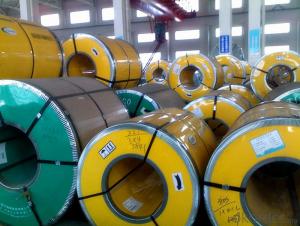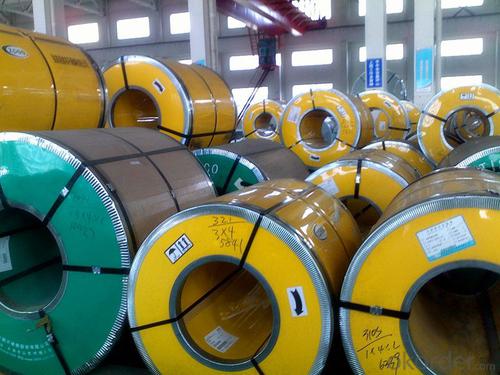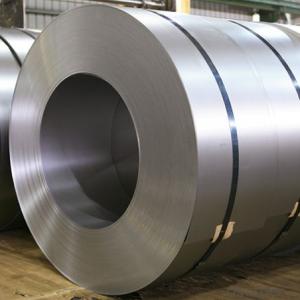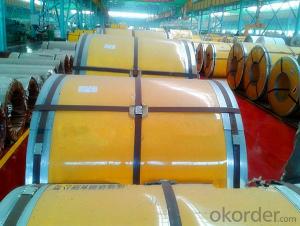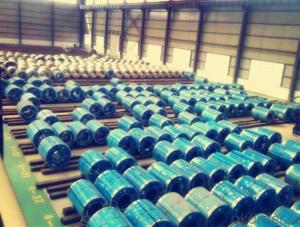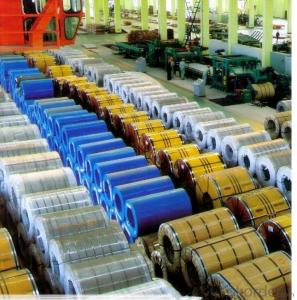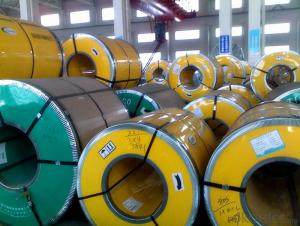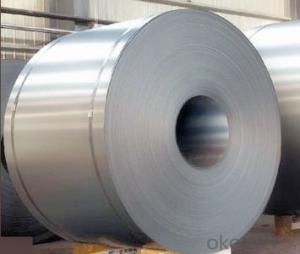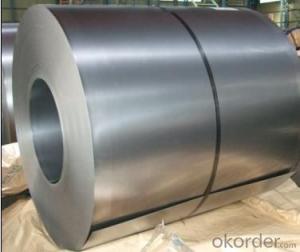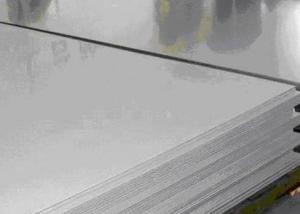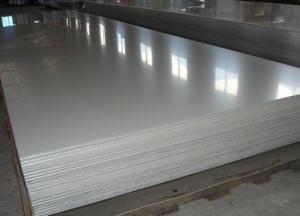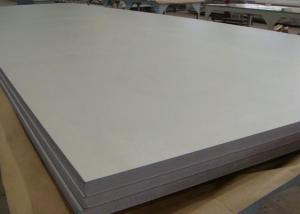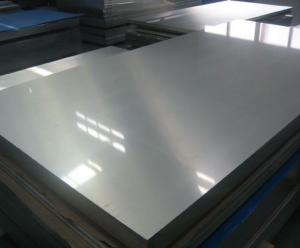Cold Rolled Stainless Steel Coil 304 2B Wide Strip
OKorder Service Pledge
OKorder Financial Service
You Might Also Like
Cold Rolled Stainless Steel Coil 304 Grade Wide Strip 2B Finish
Packaging Detail:standard export packing or as customer's requirements
Delivery Detail:7-15 days after the order
MOQ: 100mt
Standard: | AISI,ASTM,BS,DIN,GB,JIS | Grade: | 304 | Thickness: | 0.3-3.0mm |
Place of Origin: | China Mainland | Brand Name: | CNBM | Model Number: | 304 |
Type: | Steel Coil | Technique: | Cold Rolled | Surface Treatment: | 2B |
Application: | Medical instruments, building, chemical food industry agriculture | Width: | 500-2000mm | Length: | Coil |
finish: | 2B | item: | 304 cold rolled stainless steel coil | density: | 7.93 |
Chemical composition: |
| ||||||
C | Si | Mn | Cr | Ni | S | P | |
≤0.07 | ≤1.0 | ≤2.0 | 18.0~20.0 | 8.0~11.0 | ≤0.03 | ≤0.035 | |
mechanical properties: |
| ||||||
Tensile strength σb (MPa) | Conditions yield strength 0.2 sigma (MPa) | Elongation δ5 (%) | Section shrinkage (%) | Hardness | |||
520 | 205 | 40 | 60 | ≤1 | |||
- Q: Can stainless steel strips be used in electronics applications?
- Yes, stainless steel strips can be used in electronics applications. Stainless steel is known for its excellent corrosion resistance, high strength, and durability, making it suitable for various electronic components and applications. It is often used in the manufacturing of connectors, terminals, springs, battery contacts, and shielding, among others. Stainless steel strips can provide electrical conductivity, thermal stability, and resistance to vibration and mechanical stress, making them reliable for use in electronic devices. Additionally, stainless steel is non-magnetic, which can be beneficial for certain applications where magnetic interference needs to be minimized.
- Q: How do you prevent rust on stainless steel strips?
- To prevent rust on stainless steel strips, there are several measures you can take: 1. Regular cleaning and maintenance: It is important to clean stainless steel strips regularly to remove any dirt, debris, or contaminants that could lead to rust formation. Use a mild detergent or stainless steel cleaner and a soft cloth or sponge to clean the surface thoroughly. Avoid using abrasive cleaners or scrub brushes, as they can scratch the stainless steel and make it more prone to rusting. 2. Dry thoroughly: After cleaning, make sure to dry the stainless steel strips completely. Moisture can contribute to rust formation, so using a clean, dry cloth to wipe away any residual moisture is crucial. Pay special attention to areas where water can accumulate, such as crevices or corners. 3. Protect from chemicals and corrosive substances: Stainless steel is known for its resistance to corrosion, but certain chemicals or substances can still cause damage or rusting. Avoid exposing stainless steel strips to harsh chemicals, such as bleach or ammonia-based cleaners, as they can corrode the surface. If stainless steel comes into contact with corrosive substances, rinse it immediately with water and dry thoroughly. 4. Use protective coatings: Applying a protective coating, such as a clear lacquer or special stainless steel protective spray, can create a barrier between the stainless steel and external factors that could cause rust. These coatings provide an extra layer of protection and help maintain the appearance and durability of stainless steel strips. 5. Avoid exposure to saltwater or high humidity: Stainless steel can be more susceptible to rusting in environments with high humidity or exposure to saltwater. If possible, limit the exposure of stainless steel strips to these conditions. If it is not possible to avoid such environments, taking extra precautions, such as more frequent cleaning and using appropriate protective coatings, becomes even more important. By following these preventive measures, you can significantly reduce the risk of rust formation on stainless steel strips and ensure their longevity and aesthetic appeal.
- Q: Can 111 stainless steel strips be formed into wire for various applications?
- Yes, 111 stainless steel strips can be formed into wire for various applications. Stainless steel strips can undergo a process called wire drawing, where they are pulled through a series of dies to reduce their diameter and form them into wire. This wire can then be used for a wide range of applications such as electrical wiring, springs, cables, and more.
- Q: Are stainless steel strips easy to clean and maintain?
- Stainless steel strips are renowned for their ability to resist corrosion, stains, and rust, thus making them an ideal material for a wide range of applications. When it comes to cleaning these strips, a gentle approach is key. You can employ a mild detergent or soap in combination with warm water and a soft cloth or sponge. It's important to scrub the surface in the direction of the grain to prevent any potential scratching. Once cleaned, thoroughly rinse the strips and ensure they are completely dry to avoid water spots. In terms of upkeep, maintaining stainless steel strips requires minimal effort. Regular cleaning usually suffices to keep them in pristine condition. However, should you come across stubborn stains or marks, there are stainless steel cleaners and polishes specially formulated for this purpose. These products aid in restoring the strips' luster and eliminating any residue or imperfections. Moreover, stainless steel boasts remarkable durability, eliminating the need for special treatments or coatings to preserve its quality. It is also resistant to heat, making it a suitable choice for a variety of environments, including kitchens and manufacturing facilities. All in all, thanks to their inherent qualities, stainless steel strips are relatively simple to clean and maintain. By adhering to proper cleaning techniques and utilizing appropriate products, you can ensure that your stainless steel strips remain in exceptional condition for an extended period.
- Q: How do stainless steel strips resist stress corrosion cracking in chloride environments?
- Due to their inherent properties and specific alloy composition, stainless steel strips exhibit a high resistance to stress corrosion cracking in chloride environments. This resistance is primarily attributed to the presence of chromium, molybdenum, and nickel in the stainless steel alloy. Chromium, as the main component, is responsible for the corrosion resistance of stainless steel. When exposed to chloride ions, the stainless steel strips develop a passive oxide layer consisting of chromium oxide on their surface. This oxide layer acts as a protective barrier, preventing the penetration of chloride ions and reducing the likelihood of stress corrosion cracking. Molybdenum, another crucial element in stainless steel alloys, enhances their resistance to stress corrosion cracking in chloride environments. It provides additional protection by increasing the material's resistance to pitting and crevice corrosion, which can be precursors to stress corrosion cracking. Moreover, the presence of molybdenum improves the overall strength and durability of the stainless steel strips. Nickel, as an alloying element, further enhances the resistance of stainless steel strips to stress corrosion cracking. It enhances the material's ability to withstand the corrosive effects of chloride ions, minimizing the risk of crack initiation and propagation. Apart from these alloying elements, the specific composition and microstructure of the stainless steel strips also play a crucial role in their resistance to stress corrosion cracking. Optimal resistance to chloride-induced corrosion is achieved by selecting an appropriate stainless steel grade with a higher content of chromium, molybdenum, and nickel, such as 316 or 904L. Additionally, proper fabrication processes and surface treatments, like passivation, can further enhance the corrosion resistance of stainless steel strips in chloride environments. Passivation involves the removal of iron contaminants from the surface and the formation of a more uniform and protective chromium oxide layer, further reducing the risk of stress corrosion cracking. In conclusion, stainless steel strips possess a remarkable resistance to stress corrosion cracking in chloride environments due to the combined effects of chromium, molybdenum, and nickel, as well as their specific alloy composition, microstructure, and surface treatments. These factors make stainless steel a preferred choice for various industries, including marine, chemical, and oil and gas.
- Q: Can stainless steel strips be used in the construction equipment industry?
- Certainly, the construction equipment industry can utilize stainless steel strips. Renowned for its superb corrosion resistance, durability, and strength, stainless steel proves to be suitable for a wide range of construction equipment applications. In particular, stainless steel strips find utility in reinforcing structures, fabricating components, and crafting bespoke parts for construction machinery. Their impressive resistance to rust and corrosion renders them perfect for demanding outdoor tasks and heavy-duty applications. Moreover, thanks to stainless steel's exceptional strength-to-weight ratio, lightweight yet robust equipment can be manufactured, thereby enhancing efficiency and performance. All in all, stainless steel strips emerge as a valuable asset within the construction equipment industry due to their durability, corrosion resistance, and adaptability.
- Q: What are the common uses of stainless steel strips in the chemical manufacturing process?
- Stainless steel strips are commonly used in the chemical manufacturing process for various purposes such as fabricating tanks, pipes, and equipment due to their resistance to corrosion and high strength. They are also used for heat exchangers, reaction vessels, and storage tanks in order to handle and store chemicals safely. Additionally, stainless steel strips are utilized for constructing platforms, walkways, and stairs within chemical plants to ensure durability and safety.
- Q: What is the difference between hot-rolled and cold-rolled stainless steel strips?
- Hot-rolled and cold-rolled stainless steel strips refer to two different methods of manufacturing stainless steel strips, each with distinct characteristics and applications. Hot-rolled stainless steel strips are produced by heating stainless steel slabs or billets above their recrystallization temperature and then passing them through a series of rollers to achieve the desired thickness. This process results in a strip with a rough surface finish and a scaled or oxidized outer layer. Hot-rolled strips are known for their strength and durability, making them suitable for applications that require high tensile strength and resistance to deformation, such as structural components, automotive parts, and machinery. On the other hand, cold-rolled stainless steel strips are manufactured by taking hot-rolled strips and further processing them through a cold reduction mill. This involves passing the strips through a number of rollers at room temperature to decrease their thickness and improve their surface finish. Cold-rolled strips have a smoother, more polished appearance and a tighter dimensional tolerance compared to hot-rolled strips. They are commonly used in applications that demand a higher level of surface finish, precision, and flatness, such as consumer appliances, kitchenware, and decorative elements. Another significant difference between hot-rolled and cold-rolled stainless steel strips is their mechanical properties. Hot-rolled strips have a lower yield strength and higher ductility, which means they are more prone to deformation and can be easily shaped or formed. Cold-rolled strips, on the other hand, have a higher yield strength and lower ductility, making them less malleable but more resistant to deformation. This makes cold-rolled strips ideal for applications that require precise dimensions and tight tolerances. In conclusion, the main differences between hot-rolled and cold-rolled stainless steel strips lie in their surface finish, dimensional tolerance, mechanical properties, and applications. Hot-rolled strips are characterized by their rough surface finish, high strength, and suitability for structural applications, while cold-rolled strips have a smoother surface finish, tighter dimensional tolerance, and are often used in applications that demand precision and aesthetics.
- Q: What are the recommended protective measures for transporting 111 stainless steel strips?
- To ensure the safety and prevent damage while transporting 111 stainless steel strips, it is crucial that certain protective measures be taken. Here are some recommended measures to consider: 1. Packaging: It is essential to package each stainless steel strip individually to avoid scratching or rubbing against each other. Plastic wrap, foam sheets, or bubble wrap can be used for added protection. 2. Load security: To prevent any movement or shifting during transportation, securely fasten the packaged stainless steel strips. Straps, ropes, or appropriate fastening materials should be used to hold the load in place. 3. Pallets or crates: If possible, transport the stainless steel strips on pallets or in crates. This helps evenly distribute the weight and provides an extra layer of protection. Ensure that the pallets or crates are in good condition and sturdy enough to support the weight. 4. Moisture avoidance: To avoid corrosion, shield the stainless steel strips from moisture during transit. Waterproof covers or tarps can be used to protect them from rain, snow, or any other form of moisture. 5. Temperature control: If extreme temperatures are involved in the transportation, it is advisable to control the temperature inside the transport vehicle. This helps minimize potential damage caused by expansion or contraction of the stainless steel strips. 6. Handling precautions: During loading and unloading, handle the stainless steel strips with care to prevent bending, denting, or other forms of damage. Appropriate lifting equipment should be used, and personnel involved in handling should receive proper training. 7. Insurance coverage: Consider obtaining insurance coverage for the transportation of the stainless steel strips to provide financial protection in case of unforeseen accidents or damages during transit. It is important to seek guidance from transportation experts or professionals experienced in handling stainless steel strips to ensure the implementation of the best protective measures. Their expertise can help minimize the risk of damage and ensure the safe transportation of the stainless steel strips.
- Q: What are the common thickness and width combinations for stainless steel strips?
- The common thickness and width combinations for stainless steel strips vary depending on the specific application and industry. However, some commonly found thicknesses for stainless steel strips range from 0.02mm to 6mm, while the width can range from 4mm to 800mm. These combinations are widely used in various industries such as automotive, aerospace, construction, and manufacturing.
Send your message to us
Cold Rolled Stainless Steel Coil 304 2B Wide Strip
OKorder Service Pledge
OKorder Financial Service
Similar products
Hot products
Hot Searches
Related keywords
